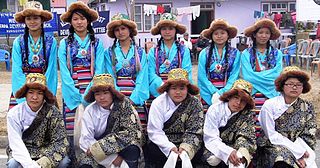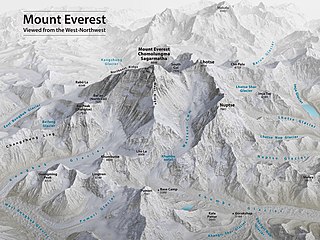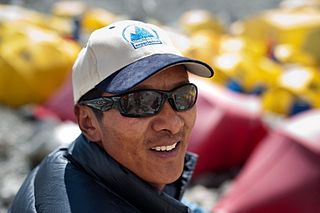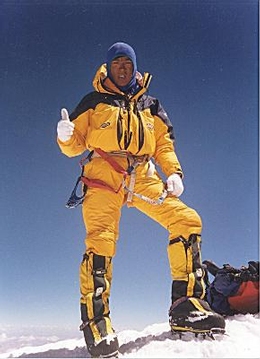
Mount Everest is Earth's highest mountain above sea level, located in the Mahalangur Himal sub-range of the Himalayas. The China–Nepal border runs across its summit point. Its elevation of 8,848.86 m was most recently established in 2020 by the Chinese and Nepali authorities.

Ang Rita Sherpa was a Nepali mountaineer who climbed Mount Everest ten times without using supplemental oxygen between 1983 and 1996. His sixth climb set the world record for the most successful ascents of Mount Everest, which he re-set on his tenth climb. Although others have since summitted Everest more, he still holds the record for most summits without supplemental oxygen. He was also the first, and to date only, person to climb Mount Everest without supplemental oxygen in winter. He was nicknamed the "Snow Leopard" by his peers.

The Sherpa are one of the Tibetan ethnic groups native to the most mountainous regions of Nepal, Tingri County in the Tibet Autonomous Region and the Himalayas. The term sherpa or sherwa derives from the Tibetan-language words ཤར shar ("east") and པ pa ("people"), which refer to their geographical origin in eastern Tibet.

Cho Oyu is the sixth-highest mountain in the world at 8,188 metres (26,864 ft) above sea level. Cho Oyu means "Turquoise Goddess" in Tibetan. The mountain is the westernmost major peak of the Khumbu sub-section of the Mahalangur Himalaya 20 km west of Mount Everest. The mountain stands on the China Tibet–Nepal Province No. 1 border.

Mount Everest is the world's highest mountain, with a peak at 8,849 metres (29,031.7 ft) above sea level. It is situated in the Himalayan range of Solukhumbu district, Nepal.
Pemba Doma Sherpa was the first Nepalese female mountaineer to climb Mount Everest via its north face, was the second Nepali woman to summit from both the north and south faces, and is one of six women to have summited Everest twice. She was the leader of the 2002 Nepalese Woman Everest Expedition. Pemba Doma Sherpa climbed Cho Oyu from the Tibetan side on 28 Sep 2005.

Phurba Tashi Sherpa Mendewa is a Nepalese Sherpa mountaineer known for his numerous ascents of major Himalayan peaks. These include 21 ascents of Mount Everest, five on Cho Oyu, two on Manaslu, and one each on Shishapangma and Lhotse.

Ang Dorje (Chhuldim) Sherpa is a Nepali sherpa mountaineering guide, climber, and porter from Pangboche, Nepal, who has climbed to the summit of Mount Everest 22 times. He was the climbing Sirdar for Rob Hall's Adventure Consultants expedition to Everest in spring 1996, when a freak storm led to the deaths of eight climbers from several expeditions, considered one of the worst disasters in the history of Everest mountaineering.

On 18 April 2014, seracs on the western spur of Mount Everest failed, resulting in an ice avalanche that killed sixteen climbing Sherpas in the Khumbu Icefall. This was the same icefall where the 1970 Mount Everest disaster had taken place. Thirteen bodies were recovered within two days, while the remaining three were never recovered due to the great danger of performing such an expedition. Many Sherpas were angered by what they saw as the Nepalese government's meager offer of compensation to victims' families, and threatened a protest or strike. On 22 April, the Sherpas announced they would not work on Everest for the remainder of 2014 as a mark of respect for the victims.
Nimdoma Sherpa from Gauri Sankar, Dolakha District is a Nepalese mountain climber. In 2008 she became the youngest woman to climb Mount Everest and in 2009 she joined the Seven Summits Women Team, a team of Nepalese women whose goal is to climb the Seven Summits.

Chhang Dawa Sherpa : is a Nepalese mountaineer and the youngest climber till 2019 to summit the 14 highest peaks. Dawa and his brother Mingma Sherpa together hold the world record as "first brothers to summit the 14 highest peaks", a single record shared by the two.
Pema Diki Sherpa is from Simigau, Gauri Sankar, Dolakha District, Nepalese mountain climber. In 2008 she became the youngest woman to climb Mount Everest and in 2009 she joined the Seven Summits Women Team, a team of Nepalese women whose goal is to climb the Seven Summits.
Lhakpa Sherpa is a Nepalese Sherpa mountain climber. She has climbed Mount Everest ten times, the most of any woman in the world. Her record-breaking tenth climb was on May 12, 2022, which she financed via a crowd-funding campaign. In 2000, she became the first Nepali woman to climb and descend Everest successfully. In 2016, she was listed as one of BBC's 100 Women.

The Mount Everest climbing season of 2017 began in spring with the first climbers reaching the top on May 11, from the north side. The first team on the south side reached the top on May 15. By early June, reports from Nepal indicated that 445 people had made it to the summit from the Nepali side. Reports indicate 160–200 summits on the north side, with 600–660 summiters overall for early 2017. This year had a roughly 50% success rate on that side for visiting climbers, which was down from other years. By 2018, the figure for the number of summiters of Everest was refined to 648. This includes 449 which summited via Nepal and 120 from Chinese Tibet.

Mount Everest in 2018 is about events in the year about the highest Earth mountain, Mount Everest, a popular mountaineering tourism and science destination in the 2010s. In 2018, 807 climbers summited Mount Everest, which is a popular mountaineering goal. This year is noted for an especially long weather window of 11 days straight of calm, which reduced crowding at the high base camps. With over 800 reaching the top, it was the highest amount ever to reach the top in recorded history, besting the previous year by over 150 summitings.

The 1965 Indian Everest Expedition reached the summit of Mount Everest on 20 May 1965. It was the first successful scaling of the mountain by an Indian climbing expedition.













